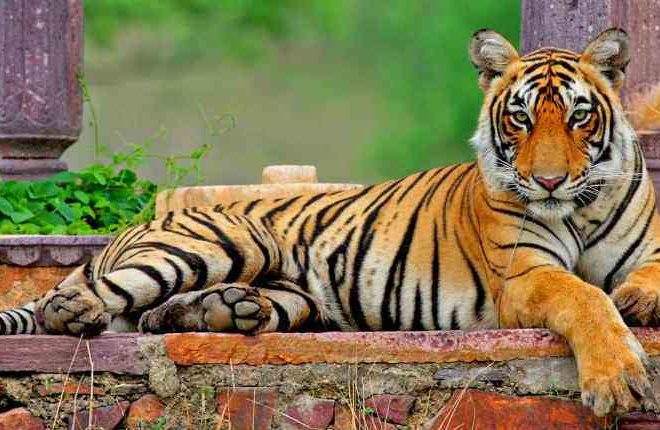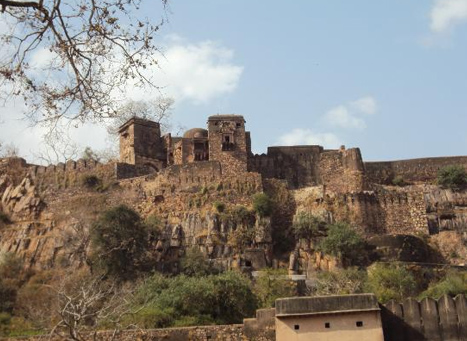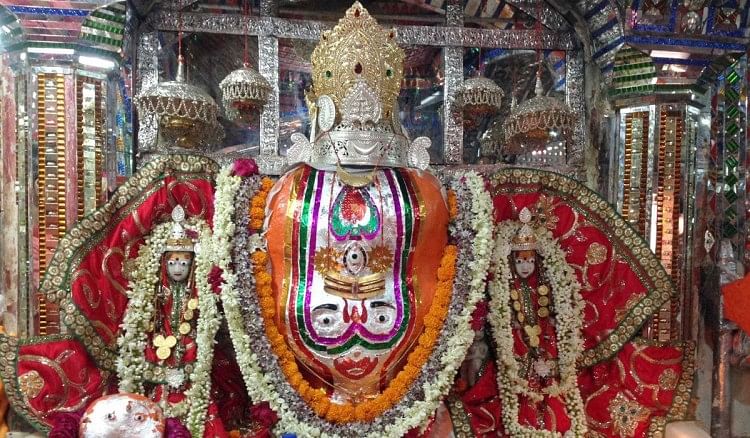Ranthambore National Park or Ranthambore is the fortieth
largest national park in northern India, covering 392 km². Ranthambhore was
established as the Sawai Madhopur Game Sanctuary in 1955 by the Government of
India and was declared one of the Project Tiger reserves in 1973. Ranthambhore
became a national park in 1980. In 1984, the adjacent forests were declared the
Sawai Man Singh Sanctuary and Keladevi Sanctuary, and in 1991 the tiger reserve
was enlarged to include the Sawai Man Singh and Keladevi sanctuaries.

Ranthambore wildlife sanctuary is known for its Bengal
tigers, and is a popular place in India to see these animals in their natural
jungle habitat. Tigers can be easily spotted even in the daytime. The best
times for tiger sightings at Ranthambore National Park are deemed to be in
November and May. The park's deciduous forests are characteristic examples of
the type of jungle found in Central India. Other fauna include the Indian
leopard, nilgai, wild boar, sambar, striped hyena, sloth bear, southern plains
gray langur, rhesus macaque, mugger crocodile and chital. The sanctuary is home
to a wide variety of trees, plants, birds and reptiles, as well as one of the
largest banyan trees in India.
Ranthambore Fort - The noteworthy Ranthambore Fort was built by the Chauhan
rulers in the 10th century. Due to its strategic location, it was ideal to keep
the enemy at bay. The fort is also related to the historical legend of the
royal women performing ‘jauhar’ (self-immolation) when the Muslim invader
Alauddin Khilji laid siege on this fort in 1303. The fort is characterised by
temples, tanks, massive gates and huge walls.

Trinetra Ganesha Temple – Ranthambore Ganesh ji is very old temple on the palace of
Ranthambore fort. It is very heart touch place for devotee and visitors.
Ranthambore Ganesh Temple dedicated to Lord Ganesha is located in the fort of
Ranthambore, about 12 kms from Sawai Madhopur It is said that; in 1299 AD,
there was a war between King Hammeer and Alauddin Khilji. During the time of
war they filled there godowns with foods and all the necessary things in
Ranthambhore Fort, where King resides. Since the war lasted for several years,
the stock in godowns were over.
One night when King Hammer; who was a great devotee to God
Ganesh, was sleeping, he dreamed that Lord Ganesh came to him and said that by
tomorrow morning all the problems and lacking would be over. In the morning an
idol of Lord Ganesh with three eyes*(Trinetra), embossed from one of the fort’s
wall. As a miracle the war was over and the godowns were full. In 1300 AD King
Hammer built a temple of Lord Ganesh and placed Riddhi Siddhi, his wife and two
sons Shub Labh along with the idol of Ganesh. His vehicle mushak (mouse) is
also placed there. Ganesh Chaturthi holds a special place in Ranthambore and is
celebrated to commemorate the origin of Lord Ganesh, who is said to have been
born on this day. The Ganesha temple in the fort of Ranthambore is one of the
most eminent Ganesha temples of Rajasthan.
Surwal Lake - Surwal Lake, a beautiful seasonal lake, is
situated at about 25 km away from Ranthambore. The lake is heaven for a variety
of birds. Travellers are mesmerised and captivated by the beauty of this lake,
especially, during the months from November to March. Surwal Lake is another
popular tourist destination, which offers beautiful view of flora and fauna in
Ranthambore. This lake is situated at a distance of 25 km from
Ranthambore. The ideal time to visit this place is during the months of
November to March, when nature presents beauty at its best. During winters,
many migrated birds can be seen at this lake. Plenty of birds which can be
witnessed by visitors are demoiselle cranes, pelicans and many others. The
place is mostly frequented by nature lovers, who can enjoy sunrise and sunset
along with the chirping of birds. Tourists should avoid visiting this place in
the months of April and May because there is no water in the lake.

Padam Talao - The famous
Ranthambore National Park is home to one of the largest lake around this place
named as Padam Talao. The name of this lake comes from the lotus flower (called
as Padam in Hindi language) that grows readily here. It is a major source of
water for animals and birds living in this national park. It is one of the
prominent places where tourists can watch different wildlife animals as they
often come here to quench their thirst. Wildlife lovers can climb the machans
that are built around this lake and watch the wild inhabitants of this park
closely.
Kachida Valley - Kachida Valley is
situated in the outskirts of the Ranthambore National Park. The valley
treasures an array of flora and fauna. A majority of the panther population of
the park is found here. Tourists can also witness sloth bears and deer in
this part of the park. Travellers can hire Safari Jeeps to tour and enjoy the
beauty of Kachida Valley. Kachida Valley is one of the picturesque and a
must-visit place in Ranthambore. It is blessed with wide range of flora and
fauna species. This area contains a majority of the Panther population of the
park. The Panthers avoid venturing into the main jungle to avoid conflicts with
tigers, which are known to kill them. Tourists can also see a variety of sloth
bears and deer in this valley. Visitors will have to reach this valley via the
jeep safari.
Jogi Mahal -The Jogi Mahal, an
elegant guest house at the foothills of the Ranthambore, was built by the royal
families of Jaipur. It served as their hunting lodge for many generations. This
forest guest house provides all modern facilities to the visitors.ranthambore
tour packages Jogi Mahal is a favorite watering hole of the animals of
Ranthambore. Tigers, Leopards, Deer, Monkeys and Peacocks can be seen drinking
at the lakes edge during the early morning and late evening. Machans or huts on
observation posts near the Padam Talao are an excellent platform from where visitors
can see the animals in their natural habitat. Genghis, one of the legendary
tigers of Ranthambore was famous for hunting deer that came to the lakeside to
drink. The hunting lodge called Jogi Mahal is situated on the banks of the
Padam Talao. The view from the Jogi Mahal is a splendid one. Jogi Mahal was
built by the royal families of Jaipur and served as a hunting abode to various
generations of Jaipur Maharajas. After the decline of ruling authorities of
Jaipur, this Mahal is turned into a guest house which offers comfortable stay
to tourists during their visit to Ranthambore.
Raj Bagh Ruins - Raj Bagh Ruins are
an agglomeration of prehistoric ruins including arches, palace outhouses, domes
and minarets. This place lies between the Raj Bagh Talao and the Padam Talao.
The Rajbagh ruins located along the banks of the lake add to its exotic ambience.
The ruins of these structures consist of broken down rooms and outhouses with
arches, partly standing walls and domes. The majestic tigers of Ranthambore can
be seen relaxing in the shade of these structures in Ranthambore National Park.
These ruins are what give the Ranthambore National Park such a unique mixture
of a wildlife reserve and a reminder of the past, which together make it one of
the most picturesque parks in the world.

Malik Talao - Malik Talao is best
known as a haven for birds and it attracts a large number of visitors. The lake
is quite important to the wildlife of the park as it serves as the source of
water and food for the animals and birds inhabited there. This small yet scenic
lake is also home to the Marsh Crocodiles. Herds of wild boar and groups of
peacocks, eagles and various migrated birds can be seen browsing along the
banks of the lake.ranthambore tour packages Kingfishers, egrets, herons, ibis,
storks and cranes are some of the commonly spotted birds at Malik Talao making
it the perfect place for bird watching in Ranthambore. Malik Talao is one of
the lakes present in the Ranthambore National Park. These water bodies are
vital for the ecosystem of the park as they act as a source of food and water
for birds and animals. The lake attracts a large bird population that includes
plovers, moorhens, herons, storks, kingfishers, kites and hawks. Crocodiles can
also be seen resting on the banks while, at times, tigers are seen too.
















0 comments:
Post a Comment